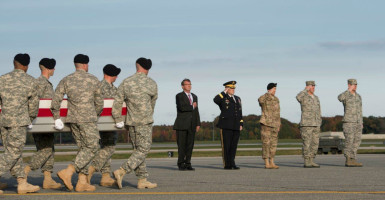Since 1775, the U.S. Army has protected America’s interests at home and abroad. American soldiers became symbols of freedom to all who encountered them. With current budget constraints, though, the Army is downsizing into what Secretary of Defense Ash Carter calls a “postwar Army.”
Nadia Schadlow and other defense experts debunk the idea of a “postwar Army” as a myth, arguing that the reality—a weak Army—poses a serious threat to U.S. capabilities and security.
The Heritage Foundation’s annual Index of U.S. Military Strength, released Oct. 28, concludes that the military overall is in decline, leaving national security vulnerable to today’s dangers. Heritage rolled out the report less than a week after President Barack Obama vetoed the annual defense authorization bill.
Schadlow, senior program officer at the Smith Richardson Foundation, said the myth claims the Army must downsize to alleviate budget constraints, but can quickly regenerate battle-ready forces when a conflict arises.
>>> Here’s Why the Slashing of the U.S. Military Budget Matters
Downsizing negatively affects training and deployment times, Richard J. Dunn III, a consultant and retired Army colonel, wrote in a 2013 paper for The Heritage Foundation.
When the Army was downsized after the Korean War, it had to grow rapidly to meet the different demands of the Vietnam War.
This rapid expansion “strained the Army’s ability to induct and train new soldiers and junior officers,” Dunn said, and ultimately “this meant that leaders were slow in adapting to the different counterinsurgency requirements of Vietnam.”
The ability to create and deploy new forces doesn’t work like an on-off switch, Schadlow and Dunn argue.
When the Army went into Iraq in 2007, “it took close to three years to build new, battle-ready brigades,” Schadlow said. Sacrificing training and the ability to rapidly respond to threats are unacceptable risks, she added.
The myth of a postwar Army also pushes the brass to shed a variety of capabilities, making the force more vulnerable to certain types of attack.
The Army’s Operating Concept, an assessment quoted by Schadlow, holds that the Army must have varying combat capabilities because of state and non-state actors around the globe posing a threat to American interests.
Gen. Ben Hodges, the top Army commander in Europe, has argued for multiple combat capabilities to “give our political leaders options.”
Military experts Dave Johnson, Steve Biddle, and Phillip Lohaus have made a similar point, noting that the 15 years of war since the 9/11 attacks required armored forces, light forces, and special operations forces.
If the Carter policy for the Army is adopted, Schadlow argues, the enemy “will adapt to evade strength and attack vulnerabilities if one capability is chosen over another.”
Similarly, a smaller Army undermines U.S. ability to fight two “major regional contingencies” at the same time, long a requirement. This strategic approach allowed the military to address a serious adversary in one theater of operations while maintaining a force large enough to deter an additional threat in a different theater.
Budget cuts have reduced the Army’s strength “from a height of 566,000 troops in fiscal year 2011 to 490,000 active-duty soldiers in fiscal 2015,” Heritage national security expert James Jay Carafano noted.
This drastic cut hinders America’s ability to respond effectively to threats, Schadlow insists.
The Army’s mission since the American Revolution has been to safeguard the principles of liberty for the U.S. and her allies.
If Congress pursues a policy that downsizes the Army into a “postwar” organization, it will create an undersized, undertrained combat force that puts both American soldiers and security in danger.
>>> For more on this topic, see The Heritage Foundation’s 2016 Index of U.S. Military Strength

























